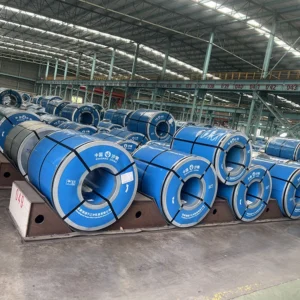Introduction
In the rapidly evolving energy landscape, the need for efficient, reliable, and sustainable materials has grown tremendously. A standout material at the heart of modern power infrastructure is cold rolled grain oriented steel. Known for its superior magnetic properties, this highly engineered steel is critical for manufacturing high-efficiency transformer cores.
With global emphasis on energy conservation, carbon neutrality, and smart grid implementation, cold rolled grain oriented steel has become indispensable in meeting performance and regulatory standards. This blog explores its technical characteristics, production process, applications, and relevance in Europe and the Middle East’s power sectors.
Understanding Cold Rolled Grain Oriented Steel
Cold rolled grain oriented steel (CRGO) is a silicon-based electrical steel, processed through cold rolling and specialized heat treatments to align the grain structure in the rolling direction. This orientation significantly enhances magnetic flux conductivity, minimizes core losses, and improves energy efficiency in static applications, such as transformers.
This steel is typically characterized by:
- High magnetic permeability
- Low core loss
- Superior insulation properties
- Consistent thickness and flatness
Its role in reducing power loss and improving transformer performance has made it a standard material in utility and industrial power systems worldwide.
Production Process
Manufacturing cold rolled grain oriented steel involves multiple precision-controlled steps:
- Hot Rolling: Initial slabs are hot rolled to reduce thickness.
- Cold Rolling: Further reduction in thickness and introduction of strain necessary for grain alignment.
- Decarburization Annealing: Reduces carbon content to improve magnetic properties and prevent aging.
- High-Temperature Annealing: Recrystallizes the steel, allowing grain orientation along the rolling direction.
- Coating Application: An insulating layer is added to enhance interlaminar resistance and reduce eddy current losses.
- Domain Refinement: Techniques like laser scribing are used to refine magnetic domains, further reducing energy losses.
Each stage is critical in developing the desired magnetic and physical characteristics essential for transformer core applications.
Key Properties and Advantages
Cold rolled grain oriented steel offers several unique properties that make it ideal for power distribution systems:
- Low Core Loss: Reduces energy loss when exposed to alternating magnetic fields.
- High Magnetic Permeability: Supports effective magnetic flux conduction in a single direction.
- Superior Dimensional Control: Enables precise stacking in transformer core laminations.
- Insulating Coating: Prevents short circuits and supports high voltage applications.
- Domain Refinement Capability: Enhances energy savings with minimal additional processing.
These advantages directly contribute to lower operating costs, enhanced system reliability, and compliance with international efficiency standards.
Applications of Cold Rolled Grain Oriented Steel
1. Power Transformers
The most critical use of cold rolled grain oriented steel is in the cores of power and distribution transformers. Its oriented grain structure allows for efficient magnetic flux transfer, resulting in reduced energy losses and improved overall transformer efficiency.
2. Instrument Transformers
These devices require high accuracy and low core loss for signal transformation. CRGO steel ensures precision and performance in current and voltage sensing equipment.
3. Renewable Energy Systems
In wind and solar power applications, transformers must manage intermittent loads. CRGO’s stability under thermal and electrical stress makes it suitable for these demanding environments.
4. Smart Grid Components
With the increasing integration of digital technology into energy systems, cold rolled grain oriented steel plays a crucial role in maintaining the efficiency and reliability of intelligent power networks.
Market Demand in Europe and the Middle East
Europe: The European Union’s strict energy regulations, including the Ecodesign Directive and the “Fit for 55” initiative, have increased demand for high-efficiency transformers. Cold rolled grain oriented steel is integral to achieving these efficiency benchmarks in both public and private sectors.
Middle East: As Gulf countries like Saudi Arabia, the UAE, and Qatar invest in grid modernization and renewable energy, CRGO steel is essential for upgrading transmission infrastructure and meeting growing electricity demands in urban and industrial zones.
Innovation and Technological Advancements
Manufacturers have continuously improved CRGO steel through several advanced techniques:
- Laser Scribing: Enhances magnetic domain alignment without compromising structural integrity.
- Thin Gauge Grades: Provide higher performance in space-constrained designs like offshore substations.
- Eco-Friendly Coatings: Meet environmental requirements while enhancing durability and performance.
- High-Silicon Content Alloys: Allow for further reduction of core losses in next-generation transformers.
These advancements have made cold rolled grain oriented steel not only more efficient but also more environmentally sustainable.
Environmental and Economic Impact
Cold rolled grain oriented steel contributes significantly to energy efficiency goals:
- Reduces transformer no-load losses by up to 30%
- Lowers CO₂ emissions through reduced power waste
- Supports grid stability with better power quality
- Improves transformer lifecycle and reduces maintenance needs
As energy prices fluctuate and climate targets become more stringent, CRGO steel offers measurable economic and environmental benefits to power utilities and equipment manufacturers.
Challenges in Supply and Production
Despite its many advantages, cold rolled grain oriented steel comes with some production and market challenges:
- High Manufacturing Complexity: Requires precise control of alloy composition and thermal treatment.
- Raw Material Availability: Relies on high-quality silicon and iron, which are subject to market volatility.
- Global Trade Restrictions: Tariffs and import/export regulations can impact regional availability.
- Capital Investment: Production facilities require significant investment in advanced equipment and skilled labor.
Manufacturers in Europe and the Middle East are responding with strategic partnerships, localization of production, and investments in R&D to mitigate these issues.
Outlook and Future Trends
With the global push toward smart cities, renewable integration, and energy efficiency, the outlook for cold rolled grain oriented steel remains strong. Key trends include:
- Increased demand from renewable energy markets
- Government-mandated transformer efficiency standards
- Integration into high-frequency and compact power devices
- Growth in energy storage and microgrid applications
As technological requirements become more sophisticated, CRGO steel will continue to evolve in composition, thickness, and coating technology.
Conclusion
Cold rolled grain oriented steel stands at the core of global efforts to enhance energy efficiency, reduce emissions, and modernize electrical infrastructure. Whether for transformers in European smart grids or power distribution systems in the Middle East, its role is foundational.
With ongoing advancements and increasing market demand, investing in high-quality CRGO steel is a smart choice for manufacturers, utilities, and infrastructure developers aiming to meet future energy needs efficiently and sustainably.




